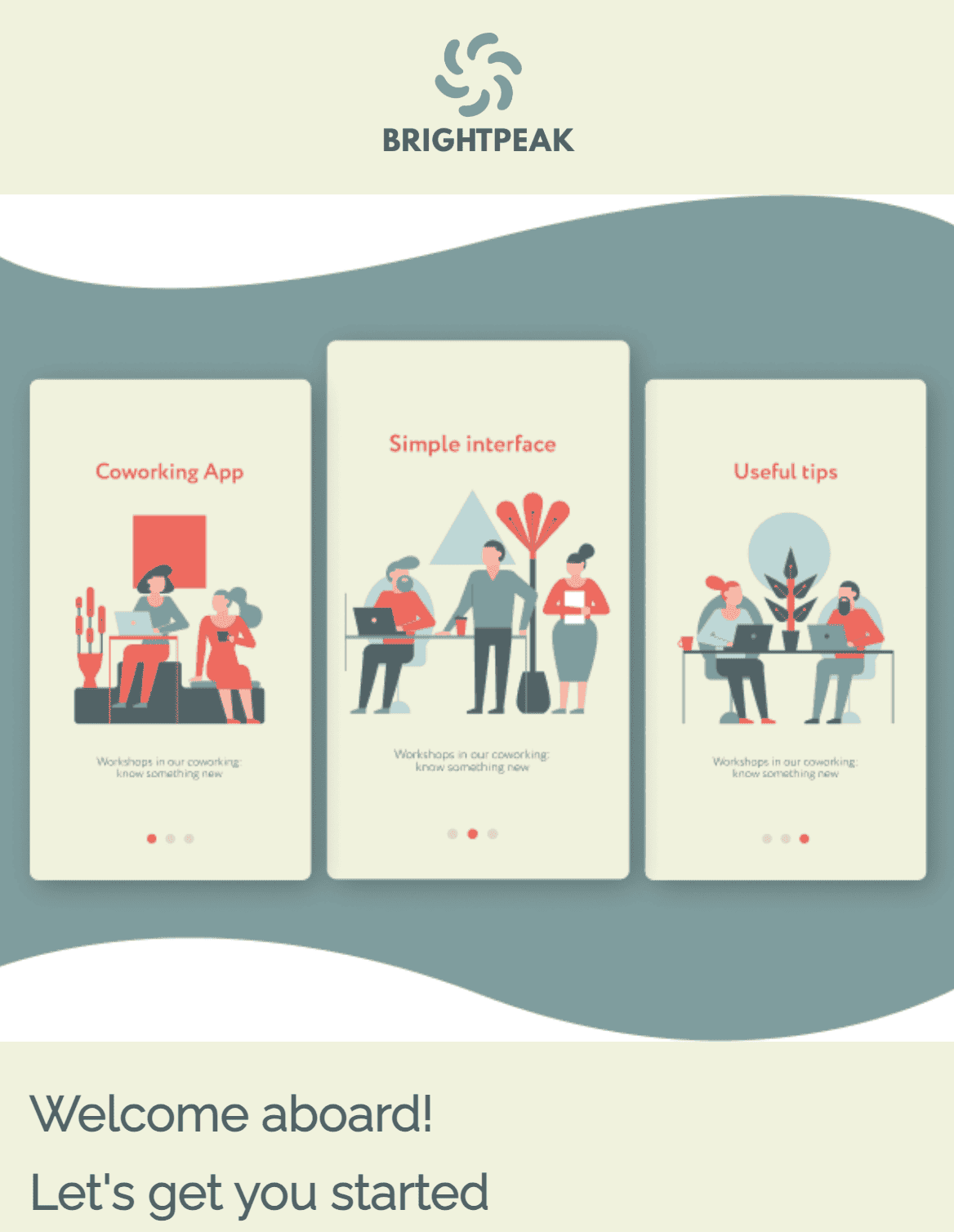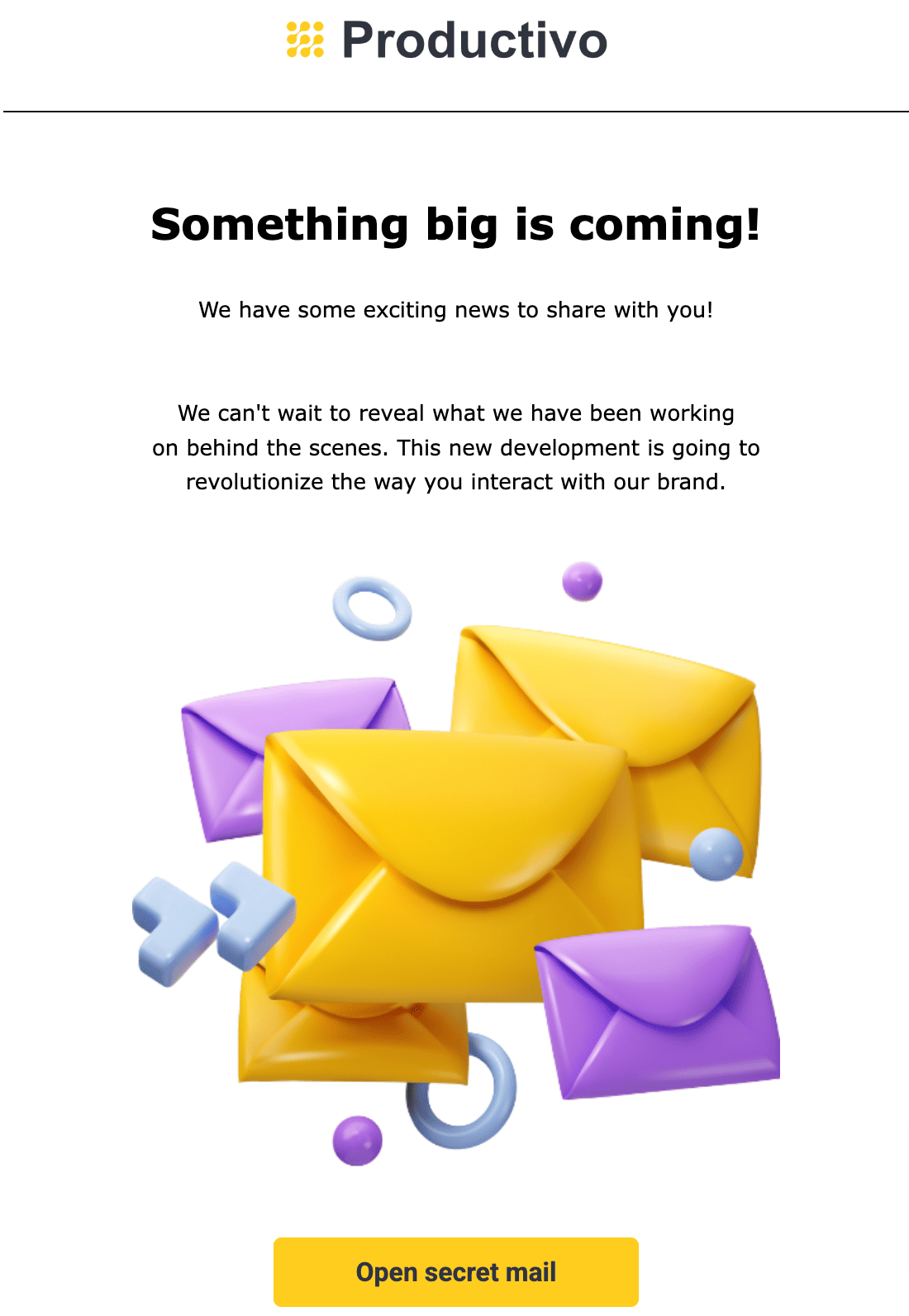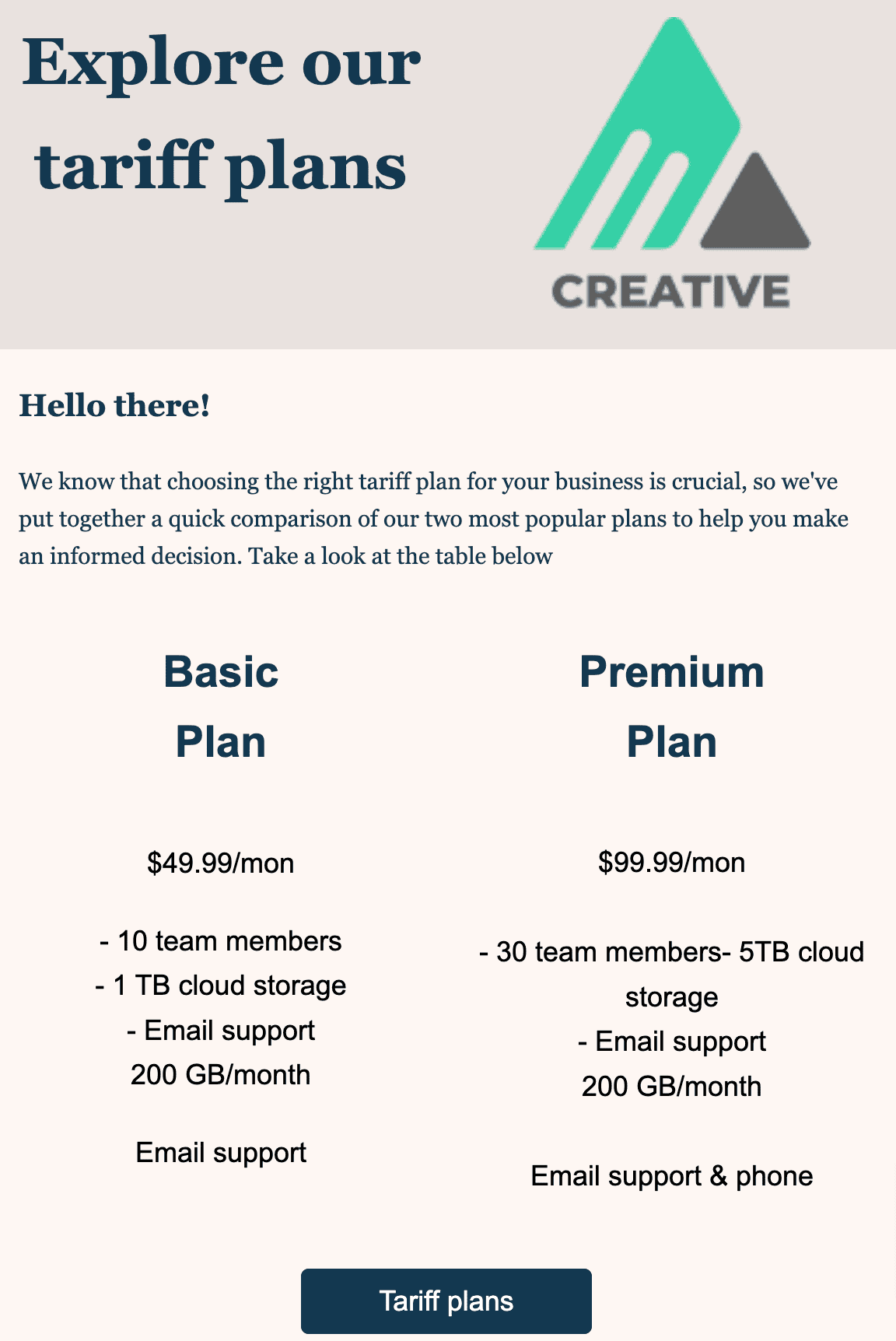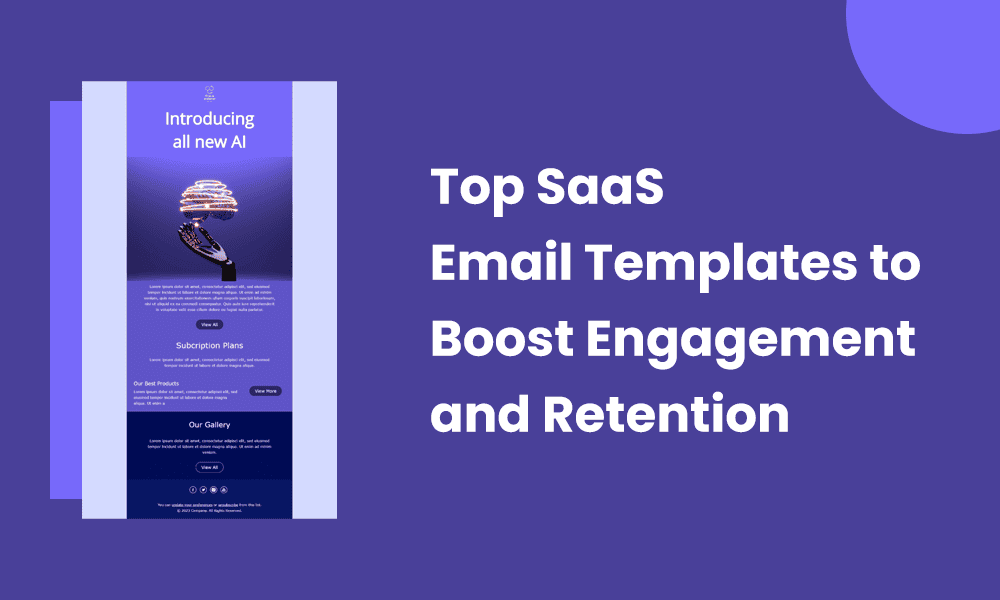The sales cycle for SaaS products typically ranges from 1-3 months for low to mid-priced solutions to 6-12 months or more for enterprise-level offerings. This makes it crucial to provide a seamless onboarding experience and maintain continuous engagement to ensure your customers stay loyal.
And what better way to achieve this than with well-crafted SaaS emails? These emails ensure your communication remains effective and consistent while helping you build lasting relationships with your users.
Whether your goal is to guide users through their first steps, nurture long-term retention, or encourage upgrades, the right email strategy can make all the difference.
In this blog, we’ll explore essential SaaS email templates designed to help you maximize customer engagement and streamline email marketing efforts.
Let’s dive in!
Table of Contents
The Different Types of SaaS Emails
Let’s cut to the chase — here are five must-have SaaS emails you should include in your marketing arsenal!
1. Onboarding emails
Onboarding is the foundation of user retention and engagement. 70% of customers will abandon your product if the initial setup takes over 20 minutes.
Even worse, 30% will delete an app if they can’t figure out how to use it properly. This underscores the importance of a strong onboarding process — where users quickly understand your product’s value and how to use it effectively, all while minimizing strain on your team’s resources.
You can break down your onboarding emails into a sequence:
- Welcome email: Greet new users and highlight key benefits.
- Initial setup guidance: Provide step-by-step instructions to help them get started.
- Feature introductions: Showcase core features and explain how to use them effectively.
Depending on your product’s complexity, you can keep it simple with one comprehensive email or build a sequence to guide users through multiple steps.
Either way, the goal is to create a smooth and welcoming experience that encourages users to take action right away.
Here’s an example of an onboarding SaaS email from Miro.
Miro welcomes you to its community of 25 million collaborators while highlighting what you can achieve with its visual collaboration platform — like using an infinite online whiteboard, accessing pre-built templates, and more.
Right below, it clarifies what to expect in upcoming emails: tips and techniques to help you effectively use Miro. The CTAs are clear and stand out, with multiple options tailored to different user needs.
It’s a concise yet highly informative welcome email that covers all the essentials.
2. Upgrade and upsell emails
Upgrade and upsell emails are key to increasing revenue and maximizing customer lifetime value. Use these emails to showcase the additional benefits they might get from subscribing to your higher-tier plans and unlock the full potential of your product.
An effective upgrade or upsell sequence might include:
- Introduction to premium features: Highlight exclusive features in higher-tier plans and explain how they can solve specific pain points.
- Personalized recommendations: Tailor your message based on the user’s current usage or behavior, like suggesting upgrades if they’re nearing feature limits.
- Limited-time offers: Create urgency with discounts or time-sensitive benefits to incentivize users to act quickly.
Pairing this with a clear CTA — like “Explore Premium Features” or “Upgrade Now” — ensures they know exactly how to take the next step.
Here’s an example of an upgrade email from Creately.
While it’s a simple text email, it effectively highlights the main message: “🚀 Upgrade Now: 50% Off Exclusive 3-Year Creately Subscription!”
This single phrase conveys the email’s purpose, the offer available, and its timeline. The email text also emphasizes the exclusive features users can unlock by upgrading, along with the savings they’ll enjoy with this deal.
Additionally, the CTA is straightforward and actionable — “Upgrade Now” is hyperlinked, making it easy for users to take immediate action. Simple, clear, and effective!
3. Engagement and nurturing emails
Engagement and nurturing emails are vital for maintaining ongoing communication with your users.
These SaaS emails are designed to keep users connected to your brand by providing valuable educational content, timely feature updates, and actionable insights.
Their primary goal is to strengthen user relationships and encourage active product usage.
An effective email templates for engagement and nurturing include:
- Newsletters: Share updates about your product, industry trends, or company milestones to keep users informed and excited.
- Tips and best practices: Provide actionable advice tailored to your users’ needs, such as how to get the most out of your product or new ways to solve common challenges.
- Feature announcements: Introduce new features or improvements, explaining how they can enhance the user experience.
- Exclusive content: Offer ebooks, webinars, or case studies to educate and inspire your audience.
These emails should focus on delivering value without overwhelming the reader.
Here’s an example from ClickUp announcing the new features and improvements to its whiteboard tool.
The email stands out by including a short video showcasing the rebuilt whiteboard and its features, giving users a clear and engaging introduction to the updates. There’s also a CTA inviting users to check the release notes, ensuring easy access to more detailed information.
What’s particularly impressive is how the email is broken into three concise sections:
- Video and announcement: Highlights the key update with a quick visual overview.
- New features and benefits: Explains what’s new and how it enhances the user experience.
- Customer feedback: Encourages users to suggest and vote on features, making them feel involved in the product’s evolution.
Each section is well-organized, with ample white space that ensures clarity and readability. The purple CTAs in every section pop against the clean background, guiding users effortlessly to take action.
This approach not only informs users but also engages them by making them feel like active contributors to the product’s improvement.
4. Transactional emails
Transactional emails ensure smooth and efficient communication between your SaaS platform and its users. These automated emails are triggered by user actions or system events, ensuring users stay informed about critical account-related updates.
Transactional emails keep communication clear, timely, and trustworthy, whether it’s about confirming account details, resetting passwords, or notifying users of billing activity.
Key types of transactional emails are:
- Account confirmations: Sent immediately after sign-up, these emails confirm the user’s account creation and may include a verification link to activate the account.
- Password resets: A crucial lifeline for users, password reset emails should be concise, include clear instructions, and ensure quick access to reset links that expire for security purposes.
- Billing notifications: These can include invoices, payment confirmations, or subscription renewal alerts, helping users stay informed about their account’s financial aspects.
One thing to note is that transactional emails need to be timely and accurate. Ensure they are clear and user-friendly to prevent frustration, especially during time-sensitive tasks like password resets.
Here’s an example of a cancellation email from LinkedIn that gets everything right.
The subject line, “You have canceled Sales Navigator Core,” is clear and straightforward, immediately letting the user know what the email is about.
The email not only confirms the subscription cancellation but also adds a touch of empathy by expressing regret: “We’re sorry to see you go!” This emotional appeal makes the message more human and could spark second thoughts.
LinkedIn smartly uses this opportunity to once again highlight the features and benefits of the canceled subscription. The email subtly tempts them to reconsider their decision.
Finally, the email wraps up with a well-placed CTA, “Manage Account,” which directs users to view their account and billing details. The structure, clarity, and tone of this email strike the perfect balance between professionalism and emotional connection.
5. Renewal and win-back emails
When a subscription is nearing its end or has already expired, a well-timed renewal email can help you retain the customer or win them back.
Renewal emails are typically sent before a subscription is set to expire, offering a courteous reminder of the upcoming renewal. Notifying customers in advance that their subscription is about to end and including the amount due is a simple gesture that customers really appreciate.
If a customer hasn’t renewed their subscription yet, you can entice them with special offers or discounts to encourage them to stay. Use clear and actionable buttons like “Renew Now” or “Extend My Subscription” to make the process smooth and convenient for them.
As for winback emails, this is a great opportunity to re-engage users who have canceled their subscriptions or become inactive. These emails should focus on acknowledging their absence with a friendly tone, letting them know that you miss them.
A simple message like “We’ve missed you” or “Come back to see what’s new” can make all the difference.
Send renewal emails at least 30 days before expiration, with follow-ups closer to the renewal date. For winback emails, experiment with timelines like 1 week, 1 month, or 3 months after inactivity.
Renewal and winback emails are more than just about retaining revenue — they’re about rekindling relationships with your customers.
Here’s a great renewal reminder email from JobHero, an AI resume builder.
The subject line, “How are you doing with your job search?”, is both thoughtful and attention-grabbing. It subtly encourages the recipient to reflect on their progress, creating a personal touch before diving into the business of subscription renewal.
Before mentioning the auto-renewal and the amount they’ll deduct, JobHero focuses on why you should continue with the service: “Stand out from the crowd and get hired faster.” This message reinforces the value of their product, reminding the user of the benefits they’re gaining.
The email clearly states that after 13 days, the subscription will be auto-renewed, allowing the user to choose before the renewal takes place.
What I like about this email is that JobHero offers customer support. If the user needs help with their job search or considering canceling, they’ve included their contact details and the hours they’re available to assist. This transparency and availability help reduce friction and build trust with the user.
How to Craft Effective SaaS Emails
From the examples shared above, we’ve identified three key elements that make SaaS emails truly effective. Let’s break them down:
1. Personalization
Personalized emails foster a sense of connection and significantly boost open and click-through rates. But effective personalization goes far beyond just adding the recipient’s first name — it’s about tailoring the message to their unique journey, preferences, and behavior.
How to implement personalization in SaaS emails
- Onboarding emails: Reference the specific features a user showed interest in during sign-up. For example, “Hi Sarah, ready to explore our advanced project tracking feature? Here’s a quick guide to help you get started!”
- Engagement emails: Recommend tips or content based on their activity. Example: “We noticed you’ve been using the collaboration feature a lot. Here’s how to take it to the next level!”
- Usage summaries: Share unique insights into their interaction with your platform. Grammarly, for instance, excels at this with its annual Writing Personality email.
Grammarly’s writing personality email example
Grammarly’s email campaign showcases a perfect blend of personalization and subtle upselling.
- Custom insights: It breaks down the user’s unique writing personality (e.g., Wunderkind, in my case), making it fun and relatable.
- Upsell opportunity: It subtly introduces features the user hasn’t explored yet, like AI-powered suggestions or premium plans.
- User appreciation: By thanking users for their loyalty (e.g., “Thanks for using Grammarly for seven years!”), it strengthens community bonds and fosters brand loyalty.
This kind of thoughtful personalization is what I’m talking about. It makes users feel understood and valued while driving engagement and conversions.
2. Design and layout
The way an email looks can make or break its effectiveness. Clean, visually appealing, and mobile-responsive designs are essential to grab attention and keep users engaged.
The balancing act: text vs visuals
Striking the right balance between text and visuals is key. Depending on the email’s purpose, you might choose:
- Plain text emails: Simple messages with clear and prominent CTAs, like Creately’s upsell email example. The minimal design puts the focus directly on the action you want users to take, driving conversions effectively.
- Visual-heavy emails: Infographics, images, or videos can be used to demonstrate features, explain complex concepts, or announce updates. For instance, ClickUp’s email showcasing its revamped whiteboard featured a short video to engage users visually.
Do not overwhelm users with too much information or too many design elements — simplicity is the key!
Here are some other best practices for saas email design.
- Use a consistent color palette aligned with your brand.
- Optimize for mobile devices; a significant portion of emails are read on smartphones.
- Incorporate white space to improve readability and avoid clutter.
Pro tip: A/B test your email designs to understand what resonates best with your audience. For example, compare engagement rates between plain text and visually rich emails to find the right mix for your brand.
3. Clear and compelling CTAs
A strong CTA is to drive user behavior and ensure your email achieves its purpose.
Whether it’s exploring a new feature, upgrading their plan, or renewing a subscription, CTAs guide users to take the next step.
A vague or hidden CTA can lead to missed opportunities. Some of the best practices for writing strong CTAs –
- Use action-oriented language like “Start Your Free Trial,” “Explore New Features,” or “Renew Now.”
- Make the CTA button prominent with contrasting colors and adequate white space.
- Place the CTA where it’s easy to spot — ideally above the fold but also repeated at the end for longer emails.
Examples of effective CTAs
- For onboarding emails: “Set Up Your First Project Now.”
- For engagement emails: “Discover New Tips.”
- For renewal emails: “Extend My Subscription.”
Best Practices for SaaS Email Campaigns
While a well-crafted email copy is crucial, real email marketing success involves more than just great content.
Strategic timing, thoughtful frequency, and consistent analysis are key to engaging your audience and driving results. Let’s explore these components in detail:
1. Timing and frequency
Find the best day and time to send emails to your target audience, as it can significantly boost your open and engagement rates.
A poorly timed email, on the other hand, risks being buried in an overflowing inbox.
Advanced email marketing automation platforms, like EngageBay, can simplify this process by tracking recipient behavior and suggesting optimal send times based on data.
Timing recommendations for different SaaS email types
- Onboarding emails: Send immediately after a user signs up or completes a specific action, such as downloading a trial.
- Renewal reminders: Start 30 days before a subscription expires, with follow-ups at 7 days and 1 day before the deadline.
- Promotional emails: Test sending times based on your audience’s habits. Weekdays during mid-morning or early afternoon often perform well, but remember, results can vary based on your audience — so always analyze and adjust.
- Transactional emails: These should be sent instantly to meet user expectations for confirmations, receipts, or password resets.
Balancing frequency
While staying in touch is important, too many emails can overwhelm users, leading to unsubscribes or complaints.
- For nurture sequences, consider sending 2–3 emails per week during the initial engagement phase, then tapering to weekly or bi-weekly communications.
- Monitor user preferences and engagement. If open rates drop or complaints increase, reassess your frequency.
Pro tip: Use segmentation to control frequency. Active users might appreciate frequent updates, while dormant users may prefer occasional check-ins.
2. Analyzing performance
If you aren’t tracking performance, you’re playing blind. Unless you track your email performance, you won’t know how it’s performing and how you can improve further.
Some key metrics that will give you insights:
- Open rates: Reflect how well your subject line and timing work.
- Click-through rates (CTR): Measure how effectively your email content and CTAs drive action.
- Conversion rates: Track the percentage of users completing the desired action (e.g., upgrading, renewing, or purchasing).
- Unsubscribe rates: High unsubscribe rates might indicate overly frequent emails or irrelevant content.
- Bounce rates: Identify deliverability issues and ensure your email list is clean.
Use email marketing platforms like EngageBay, Mailchimp, HubSpot, or ActiveCampaign to track real-time metrics. These email platforms offer real-time dashboards to visualize trends and pinpoint areas for improvement.
Pro tip: Set benchmarks for each campaign type. For example, transactional emails typically have higher open rates, while promotional emails may have lower ones. Compare your metrics against industry standards to gauge success.
3. A/B testing
A/B testing helps you understand what resonates with your audience by comparing variations of your emails.
Testing email elements allows you to optimize performance over time. Small changes can have a significant impact on open rates, click-through rates, and conversions.
What to test
- Subject lines: Compare straightforward subject lines (e.g., “Your trial ends tomorrow”) versus curiosity-driven ones (e.g., “Don’t let this opportunity slip away”).
- Call-to-action (CTA): Test different CTA text or button colors and placement.
- Visuals: Assess whether users respond better to plain text or visually rich emails. For instance, compare a product-focused email with an infographic versus one with a simple image.
- Send times: Experiment with morning versus afternoon or weekday versus weekend emails.
Pro tip: Test one variable at a time for accurate results, and use a large enough sample size to ensure statistical significance.
Use EngageBay’s Free SaaS Email Marketing Templates
Building SaaS emails can feel overwhelming, especially when aiming to hit the sweet spot of engagement and conversions. That’s where EngageBay steps in to make your life easier.
EngageBay is more than just a platform for pre-built email templates—it’s a comprehensive email automation solution. With EngageBay, you can:
- Grow your contact list through seamless integrations and sign-up forms.
- Segment your audience for targeted and personalized communication.
- Design email sequences that cater to every stage of the customer journey.
- Execute campaigns effortlessly using event-based triggers and automated workflows.
Its email marketing tools are tailored for SaaS businesses, helping you create, personalize, and optimize email campaigns without breaking a sweat.
Pre-designed email templates
EngageBay offers a rich library of email templates that cater to various SaaS needs, such as:
Onboarding emails: Welcome new users and guide them to key features.

Engagement emails: Reconnect with inactive users or promote new features.

Upsell emails: Highlight premium plans or add-ons to encourage upgrades.

Customize your email templates with our drag-and-drop editor
Not a design expert? No problem! EngageBay’s intuitive editor lets you customize templates easily.
- Modify colors and fonts to match your brand identity.
- Add your logo, images, and links with a simple drag-and-drop interface.
- Experiment with layouts without needing any coding skills.
You can watch the video here to learn how to do it.
Wrap Up
Well-crafted SaaS emails are more than just communication tools — they’re opportunities to connect, engage, and drive meaningful action.
From onboarding new users to re-engaging dormant ones, the right email can make all the difference in building long-term customer relationships.
With EngageBay’s intuitive tools and customizable email templates, you have everything you need to create emails that resonate.
Remember, effective email strategies aren’t static — they require continuous testing, analyzing, and adapting to meet your audience’s evolving needs. Start leveraging EngageBay today and empower your SaaS email campaigns to achieve their full potential!
Sign up for a free demo here.
FAQ
1. What should be included in a SaaS onboarding email?
An effective Saas onboarding email should include a warm welcome, a quick overview of key features, links to helpful resources, and clear next steps to get started with your platform.
2. How often should I send engagement emails to SaaS users?
Start with sending 1–2 engagement emails per week, depending on your audience’s activity levels, and adjust frequency based on user preferences and response rates.
3. What are some common mistakes to avoid in SaaS emails?
Some common mistakes to avoid in SaaS emails are using overly generic content, unclear CTAs, and sending too many emails. Always ensure emails are personalized, visually appealing, and relevant to user needs.
4. How can I measure the success of my SaaS email campaigns?
With an email marketing automation platform, you can track key metrics like open rates, bounce rates, and click-through rates. These insights help you analyze engagement and fine-tune your campaigns for better results.
5. Can I automate my SaaS emails? If so, how?
Yes, you can automate SaaS emails using an email marketing platform. Tools like EngageBay allow you to set up triggers and workflows for onboarding, engagement, renewal reminders, and more, saving time while ensuring timely and personalized communication.







